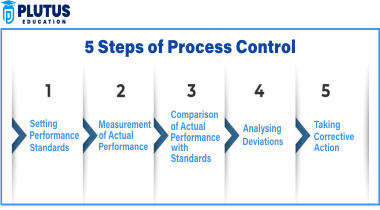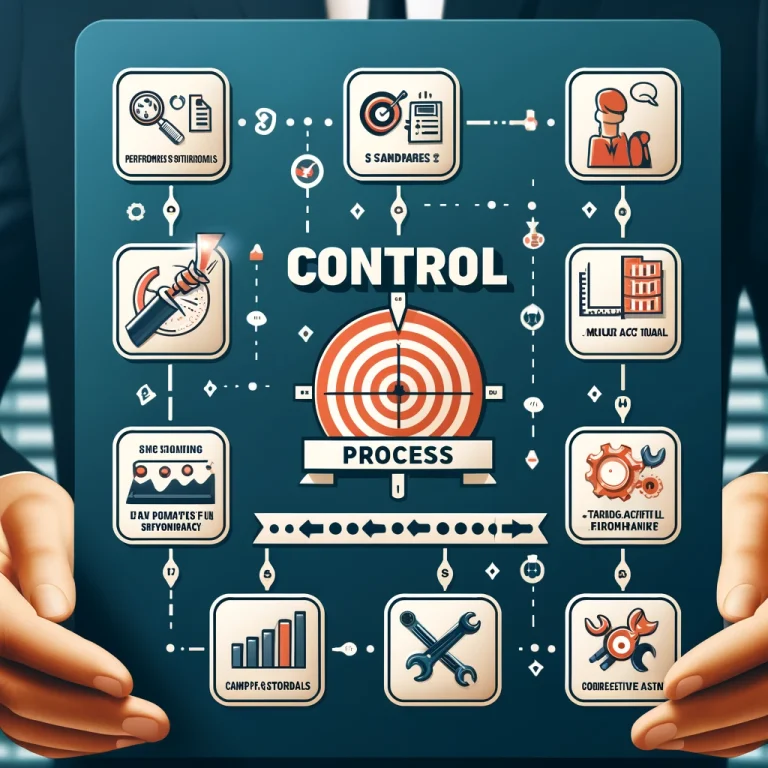The steps in the control process describe the management process that ensures the effective and efficient achievement of organizational goals. Controlling is a major function of management; it monitors and evaluates activities to determine that the given desired objectives have been achieved. Its performance step analysis allows for identifying deviations and corrective action to keep an organization on the right track. This structured approach ensures and maintains organizational health and yields real outcomes against established standard conditions.
What is Controlling in Management?
One of the essential management functions is controlling, where actual performance is checked to ensure that it meets set standards. This, therefore, checks actual performances with the expected results and takes some corrective action when there is a deviation. Control ensures that activities carried out in an organization are properly aligned with its objectives and goals.
Importance of Controlling in Management:
- Ensures efficiency by reducing errors
- Helps in achieving organizational objectives
- Monitors and evaluates employee performance
- Identifies areas for improvement and innovation
Types of Control
Different types of control are employed in organizations depending on the time they are applied or their purpose. These types ensure comprehensive oversight of processes and activities.
1. Feedforward Control: This is applied before a process takes place. It prevents problems by ensuring the proper setup of resources and processes.
2. Concurrent Control: This happens in the execution of processes. It monitors ongoing activities to ensure that they are in line with standards and performance objectives.
3. Feedback Control: Feedback control occurs after the process or activity has been completed. In this case, one measures the final output against the expected output in determining whether the entire process has been effective.

Steps in Control Process
The control process consists of a sequence of systematic steps that managers follow to monitor and regulate organizational activities. The following are the key steps in the control process:
Step 1: Setting Performance Standards
Performance standards would guide comparison of the actual performance against which a level of performance can be measured. Such standards are quantitative or qualitative criteria that reflect the organizational goals.
- Quantitative standards could be revenue targets, production volumes, or cost percentages reduced.
- Qualitative standards could be customer ratings of satisfaction or quality control metrics.
Clear and achievable standards set a very clear direction for employees and management.
Step 2: Measurement of Actual Performance
Actual performance of employees, departments, or processes is measured. The correct ways of collecting data are utilized to check what has been achieved and what was planned.
- Actual performance can be measured in terms of KPIs (Key Performance Indicators), financial reports, productivity reports, and quality assessments.
- Tools such as performance reviews, surveys, and benchmarking help in evaluating the actual outcomes.
Step 3: Comparison of Actual Performance with Standards
It measures the real performance and compares it to the standards set before the task is undertaken. Comparison for managers gives an impression about how much deviation there would be in terms of desired performance.
- Deviations could be positive above, as expected, or negative lower, than what is estimated as per expectations.
- At this step, variances thus may become a wonderful analytic tool for comparing planned with the actual outcome.
Step 4: Analysing Deviations
Once deviations are identified, managers have to look into their causes. Not all deviations require correcting; some are minor or fall within an acceptable range. This step requires a difference between significant and insignificant deviations.
Types of deviations include:
- Unfavorable variances (cost overruns, lower production)
- Favorable variances (higher profits or productivity)
- The analysis could focus on factors such as resource allocation, employee performance, or external market conditions.
Step 5: Taking Corrective Action
The final step is management correcting the systematic deviation. Corrective action has to readjust performance toward standard or revise standards if it is wrong.
Corrective actions could involve:
- Revising operational procedures
- Enhancing employee training
- Adjusting resource allocations
- Modifying organizational policies or strategies
By taking corrective action, the organization ensures continuous improvement and better alignment with its objectives.
Performance Standard → Measurement → Comparison → Analysis → Corrective ActionConclusion
Steps in control process are crucial to organizational performance, and they ensure that goals are attained in a very effective manner. Standard setting, measuring performance and comparing results, analyzing deviations, and taking corrective actions enable managers to ensure that teams and processes are aligned with the overall objectives of the organization. Control not only ensures attainment of targets but also organizational process improvement.
Steps in Control Process FAQs
What is the importance of setting performance standards in the control process?
Performance standards provide a benchmark for measuring actual performance, ensuring that activities align with organizational goals.
How does concurrent control differ from feedback control?
Concurrent control is applied during the process to monitor ongoing activities, while feedback control occurs after the process to assess the final outcome.
Why is it important to analyze deviations before taking corrective action?
Analyzing deviations helps identify the root causes of performance issues and ensures that corrective actions are targeted and effective.
Can corrective actions always resolve performance issues?
While corrective actions are designed to address performance gaps, their effectiveness depends on accurate analysis and appropriate implementation.
What is the role of performance measurement in the control process?
Performance measurement provides the data needed to compare actual outcomes against set standards, helping managers identify where deviations occur.


